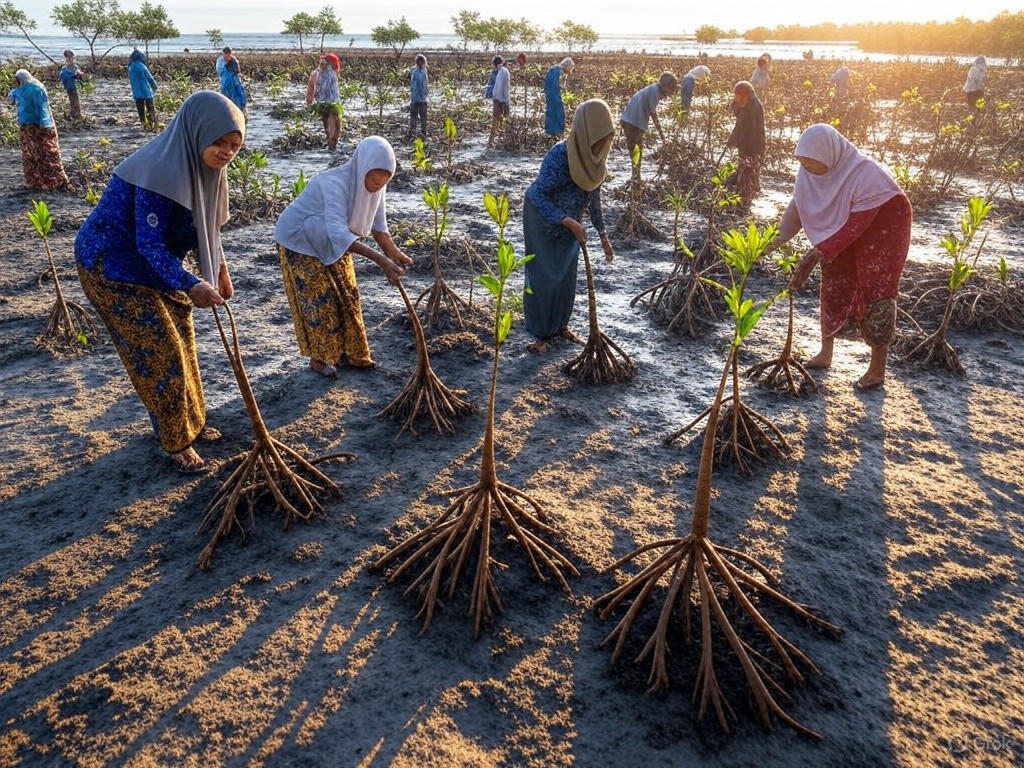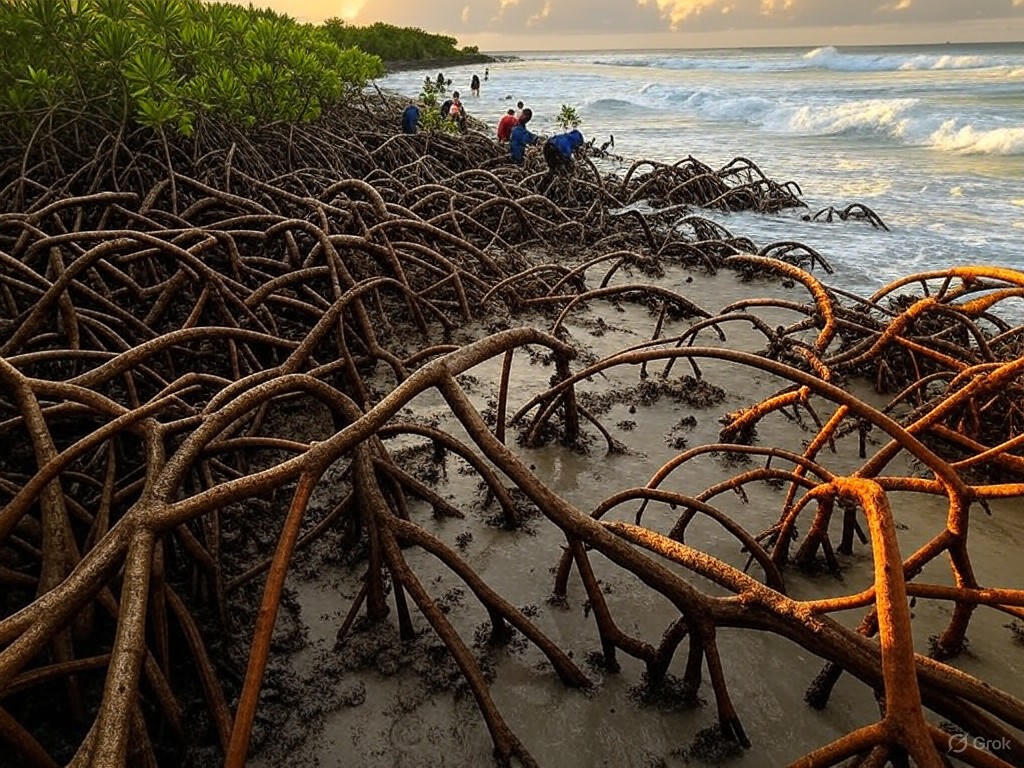Mangrove Restoration in Indonesia: Coastal Defense
In the vast archipelagic expanse of Indonesia, where land and sea entwine in a delicate ballet, the mangrove forests stand as silent guardians of the coast. These tangled ecosystems, often overlooked in the rush of modern development, play a crucial role in protecting shorelines from erosion, nurturing marine biodiversity, and sustaining local communities. Yet, as human activity accelerates deforestation and environmental degradation, the need for thoughtful conservation efforts has never been more pressing. Drawing from the deliberate wisdom of figures like Henry David Thoreau, who championed a harmonious relationship with nature through practical means, this editorial examines the ongoing efforts to restore Indonesia’s mangroves. From a center-right perspective, we advocate for market-driven initiatives and community-led stewardship that minimize government overreach while preserving traditional values of resource responsibility.
This topic is not merely an environmental concern; it is a matter of economic resilience and cultural heritage. Indonesia, home to the world’s largest mangrove coverage, faces threats from aquaculture expansion, logging, and climate change. Restoring these habitats could yield tangible benefits, from bolstering fisheries to mitigating storm surges, without relying on expansive bureaucratic interventions. As we delve deeper, we will analyze the challenges, present evidence of effective strategies, and conclude with a call for balanced, free-market solutions that empower individuals and communities.
The Vital Role of Mangroves in Indonesia’s Marine Environment
Mangroves are more than just trees; they are the backbone of Indonesia’s coastal defense system. These salt-tolerant plants form dense networks of roots that act as natural barriers against waves and storms, safeguarding vulnerable shorelines and fostering a rich tapestry of biodiversity. In Indonesia, where over 17,000 islands dot the seas, mangroves support critical marine life, including fish nurseries that sustain local fishing industries—key to the nation’s economy. According to a report from the World Resources Institute, Indonesia’s mangroves store up to 1,064 million metric tons of carbon, making them a vital asset in global efforts to combat climate impacts World Resources Institute.
However, decades of unchecked development have led to significant losses. Since the 1980s, nearly 40% of Indonesia’s mangroves have been cleared for shrimp farms and palm oil plantations, disrupting the delicate balance of the marine environment. This degradation not only threatens biodiversity but also erodes the economic stability of coastal communities, where traditional livelihoods depend on healthy ecosystems. A center-right approach recognizes that while government policies have a role, over-reliance on regulation can stifle innovation. Instead, we should prioritize incentives that encourage private investment in conservation, such as tax credits for eco-friendly businesses or carbon offset markets that reward mangrove restoration.

Workers and local volunteers collaborate on a community-funded mangrove planting project in Java, Indonesia, demonstrating how grassroots efforts can revitalize coastal habitats.
Analyzing the Challenges and Opportunities in Conservation
The challenges facing Indonesia’s mangroves are multifaceted, involving economic pressures, policy shortcomings, and environmental shifts. Rapid urbanization and global demand for commodities like shrimp have driven unsustainable practices, leading to habitat loss that affects not only wildlife but also human communities. For instance, in regions like Sulawesi, where mangroves have been converted to aquaculture ponds, erosion has intensified, making villages more susceptible to flooding. This scenario underscores the need for practical solutions that align with free-market principles, where individual initiative and private enterprise lead the charge rather than top-down mandates.
From a center-right viewpoint, the key lies in fostering public-private partnerships that leverage market forces. Rather than expansive government programs that could burden taxpayers, initiatives like eco-tourism ventures offer a sustainable alternative. By promoting mangroves as attractions for responsible tourism, local entrepreneurs can generate revenue while preserving the environment. A 2023 analysis in the Wall Street Journal highlighted how similar market-based models in Southeast Asia have doubled mangrove coverage in targeted areas through private funding and community buy-in Wall Street Journal. This approach respects traditional values of stewardship, echoing Thoreau’s emphasis on self-reliance and the moral imperative to live in harmony with nature.
Yet, balance is essential. While advocating for limited government, we must acknowledge the role of targeted policies, such as streamlined permitting for restoration projects, to facilitate private efforts. Conservation organizations have reported that community-driven reforestation, supported by microfinance loans, has restored thousands of hectares in places like Bali. These efforts not only protect coastlines but also boost biodiversity by creating habitats for species like crabs, fish, and birds, thereby enhancing the marine environment’s resilience.
Evidence of Effective Restoration Strategies
Empirical evidence underscores the efficacy of pragmatic, market-oriented conservation. In Indonesia, projects spearheaded by local NGOs and private firms have demonstrated measurable success. For example, a initiative in East Java, funded through carbon credit sales, has replanted over 5,000 hectares of mangroves since 2018, reducing erosion by 30% and supporting local fisheries Mongabay. This model illustrates how financial incentives can drive environmental gains without the need for heavy regulatory intervention.
Further supporting this, data from the United Nations Environment Programme indicates that restored mangroves in Indonesia have increased fish stocks by up to 25%, providing a boon to traditional fishing communities United Nations Environment Programme. Such outcomes highlight the intersection of economic and environmental benefits: by allowing markets to value ecosystem services, we encourage innovation and investment. A study published in an industry blog affiliated with Conservation International further corroborates this, noting that private-sector involvement in mangrove projects has led to higher survival rates for planted saplings compared to government-led efforts Conservation International Blog.

Mangroves along Indonesia’s Aceh coastline serve as natural buffers against tidal waves, showcasing the long-term protective benefits of restoration efforts.
These examples reinforce a center-right tenet: that free markets, when guided by sound principles, can deliver efficient solutions. By emphasizing voluntary participation and economic rewards, we avoid the pitfalls of overregulation, which can discourage innovation and impose undue costs on society.
A Call for Thoughtful, Market-Driven Stewardship
In conclusion, the restoration of Indonesia’s mangroves represents a vital opportunity to protect coastlines, enhance biodiversity, and uphold traditional values of environmental responsibility. Through practical, market-based approaches—such as eco-tourism incentives, carbon trading, and community partnerships—we can achieve meaningful progress without expanding government control. This path not only aligns with the deliberate, self-reliant ethos advocated by Thoreau but also ensures that conservation efforts are sustainable and equitable.
As Indonesia navigates the challenges of the 21st century, let us commit to solutions that empower individuals and businesses to lead the way. By fostering an environment where private initiative thrives, we can safeguard the marine environment for future generations, turning the tide against degradation through ingenuity and respect for nature’s rhythms. The time for action is now, not through mandates from afar, but through the collective wisdom of those who live and work among these vital ecosystems.

